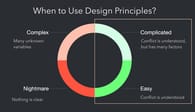What Are Design Principles?

- #Product Design
- #Design Principles
• 7 min read
How do companies like Spotify, Netflix, and MacPaw create great products? In addition to some magic, their teams are guided by what we call Design Principles.
Design Principles is not about design, well.. at least not entirely about UX and UI, as many may think.
Design Principles is a simple framework of values that describe specific goals required for the success of a product.
A brief illustration of Design Principles in action
Let me use an example to illustrate how Design Principles impact product design.
Imagine that you are working on a banking application, and one of the design principles is to ensure user safety. Your team has two design options, and opinions are divided.

Selecting the best option can be challenging, as some team members favor option 1 for its heightened security, while others advocate for option 2 due to the reduced steps to access information. However, by evaluating each alternative against the design principle of prioritizing user safety, it becomes clear that option 1 is the more suitable choice.
What are Design Principles?
Design principles are …
- NOT generic usability guidelines
- NOT work processes
- NOT a set of features
- NOT a visual style description
Instead, design principles describe what the product should be and what quality it will be after applying the principles.
In his article, my colleague Kyrylo Levashov argues that the work of a product designer is to shape the product. Ultimately, Design Principles is what guides the shaping process.
How to establish Design Principles?
Top-down method: The mission of the organization, brand values, interviews with stakeholders, and KPIs.
Bottom-up method: Usability testing, user interviews, user surveys, and market research.
Mixed method: Usability testing, organization’s mission, user surveys, KPIs.
In general, there are two ways how virtually anything is done in organizations: top-down or bottom–up. After examining many cases, I have come to the conclusion that the most sensible way is to mix the two approaches into one.
Who determines Design Principles?
The answer is simple. Everyone who will be working on a product should be involved!
What makes great Design Principles?
The design will only work if it’s built with quality and value in mind. I agree that quality and value are very vague concepts, but we can make them more tangible by adding two ingredients: specificity and necessity.
Specificity
Design “specificity” is concerned with functionality, content, and users. Let’s look at the example of eBay.

In their design principles, eBay declares the prevalence of buyers over sellers. This principle is then reflected in the business domain when eBay determines whose interests to protect in a conflict.

Practice Specificity
I have some practice for you. Let’s play a quick game where you connect a description of a specific design principle (1-3 in the table below) with one of these products:
- Social Media App;
- Search Engine;
- Project Management System.
Your job is to match these products with the following design principles.
- A: Invite users to explore. Prioritize relevance. Convey trust. Earn money. Quick and concise, with an option to expand.
- B: Simple and intuitive. Seamless experience. Colorful. Visually expressive.
- C: Focus-oriented. Has no interferences. Clarity over expressiveness. Intentional interactions. Progressive discovery.
The correct answer: 1 - B, 2 - A, 3 - C.
This exercise showcases how design principles can be specific to each product.
Necessity
Design “necessity” determines what is needed for the product.
To determine what is needed, you must prioritize principles that are essential for the product’s success in the real market and in the context of real users.

At this step, you must remember, “Not all good is necessary.” Your job is to stick to the principles that are vital for your product's success. Define them as clearly as you can and stick to them.
Design principles from a larger context
1. Differences within an organization. What’s good for one product may be different from what’s good for other products within the same organization.

Notice how hypothetical design principles are different for Facebook's social media division and Facebook business.
2. Business strategy. Design principles don’t exist in a vacuum, meaning they have to reflect and augment business strategy.

To that end, good design principles exclude deal-breakers and include differentiations. Consider any finance or healthcare product for a second. It must have security as one of the principles, or else people wouldn’t use it; it would be a deal-breaker!
Benefits of having Design Principles
We did our homework, used a mix of top-down and bottom-up methods, considered the business context, and created design principles that are specific and necessary to our product’s success. Now, the task is to apply the principles.
So what do design principles give us?
1. Quicker decisions
You can spend less time making decisions.
How many issues does a product team have to solve to develop a product? A whole lot of issues! The decision-making process is lengthy as designers, owners, and engineers debate their perspectives.

Design Principles create a benchmark for evaluating competing ideas. This applies to major and minor decisions boosting overall productivity.
2. One vector
You can set the vector for development with design principles. They articulate what’s needed for the product’s success, thereby setting a clear vector for development.

In this example, Spotify praises diversity and cultural differences in the various markets it operates. As you can see, the principle is reflected in its music categories and album covers.
The best part about design principles is determination. When your team commits to improvement, you already know what to do. Here’s another example where a principle of having quick access to product information guides redesign.

When to Use Design Principles?
I’ve mapped four types of decisions in the figure below: easy, complicated, complex, and nightmare. You should utilize design principles when the issue is relatively clear, as they work well for making quick decisions in the "green zone" (highlighted below). For the "red zone," principles can only serve as hints to transition from red to green.

Conclusions
To sum up, design principles are a set of fundamental propositions that are essential to a product's success. They set the vector for development and speed up decision-making.
We’ll go further into this topic in the next articles, uncovering how we created Design Principles for Setapp. So stay tuned!
While you wait, I invite you to think of design principles for your own product or check the design principles of other companies.
Resources
This is an independent publication and it has not been authorized, sponsored, or otherwise approved by Visa Inc, eBay Inc, Spotify AB.






